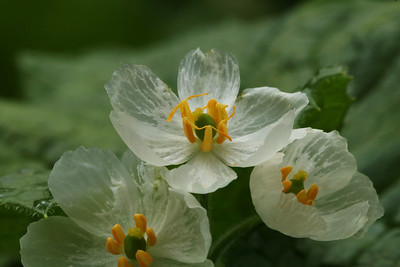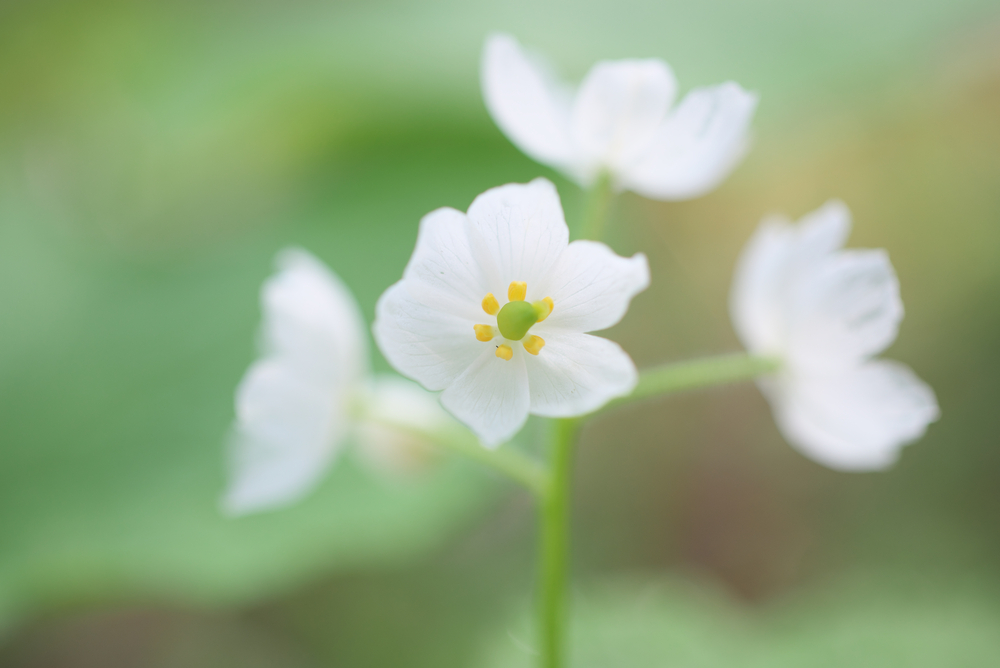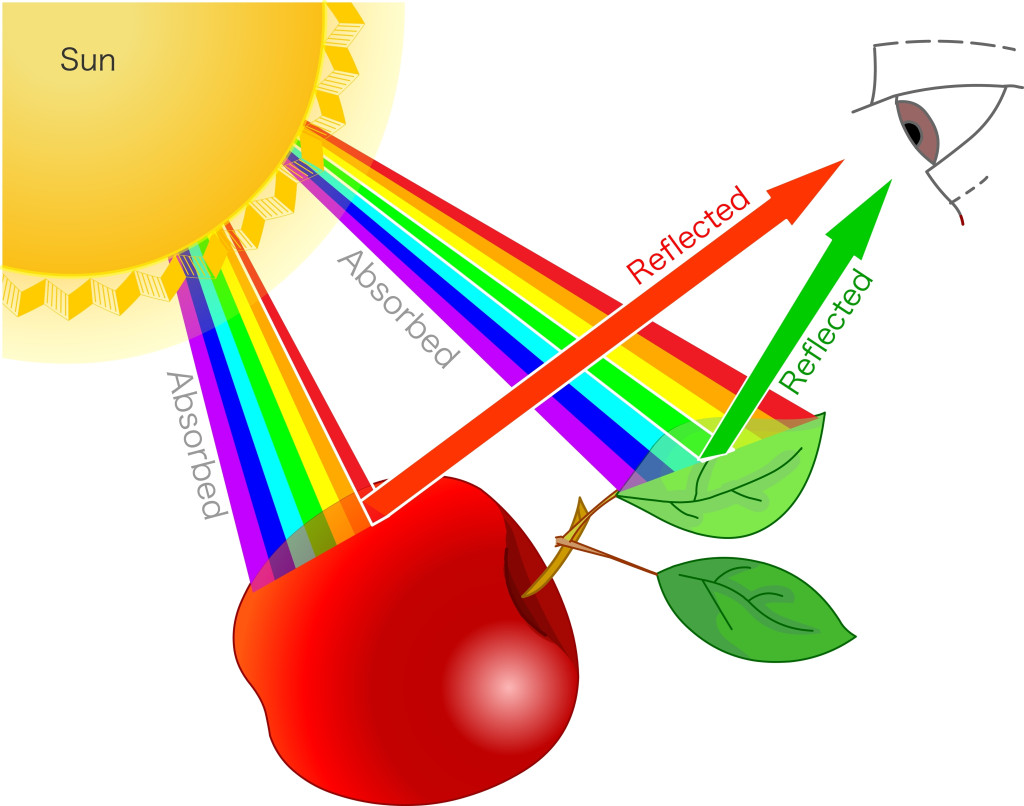Table of Contents (click to expand)
Skeleton flowers appear white when dry, as they contain air pockets that reflect light. When it rains, the water fills those same air pockets. The water and the flower’s cytolymph share a similar refractive index, so the light is able to pass through the flower without being reflected. The flowers now look transparent!
Skeleton flowers are, unlike actual skeletons, delicate white flowers that turn translucent when they are drenched in rain. Scientifically, it is known as Diphylleia grayi (and belongs to the family Berberidaceae); they are rare in nature, found in forest patches in only three countries around the world—the United States, China and Japan. No other flower in nature shows this incredible ability.
What’s the story here?

Diphylleia grayi turns transparent as water fills the air spaces between the cells. (Photo Credit : Flickr)
It’s Not Just Any Other White Flower…
You have probably seen many white-flowered plants, and under dry conditions, the skeleton flower appears just like the rest of these flowers. Now, the obvious question is, why don’t we see every white flower turn transparent during a storm? Why doesn’t the white-petalled daisy or a white rose turn translucent?
Plants spend a significant amount of their energy on synthesizing flower pigments to attract pollinators. About 95% of white flowering angiosperms carry pigments, such as flavones and flavonols, that give their flowers the white color. However, that’s not what makes Diphylleia white. It doesn’t spend its energy resources on flower pigments. Instead, it is white because of its structure.
 Under dry conditions, skeleton flowers appear white, owing to the air spaces between them, which lead to light reflection. (Photo Credit : rock ptarmigan/Shutterstock)
Under dry conditions, skeleton flowers appear white, owing to the air spaces between them, which lead to light reflection. (Photo Credit : rock ptarmigan/Shutterstock)
Also Read: What Makes Flowers So Colorful?
The Structure Of The Petal Matters
Any object visible to our eyes results from the light reflecting from it. For example, a plant’s leaves appear green because the chlorophyll pigments in the leaf reflect the green wavelength, while highly absorbing the blue or red wavelengths of the visible spectrum.
What about white objects? All the visible spectral wavelengths combine to make up white light, so for anything to appear white, it must reflect all of the visible spectrum.
 Every object we can see is a result of the visible spectrum wavelength that it is reflecting. (Photo Credit : grayjay/Shutterstock)
Every object we can see is a result of the visible spectrum wavelength that it is reflecting. (Photo Credit : grayjay/Shutterstock)
In white flowers with pigments, it is the pigments that are absorbing the light. Diphylleia get their white color based on how its cells scatter light.
The flower has air spaces between its loosely packed cells. The air in these empty spaces reflects all the wavelengths of lights. It is this reflection that makes the flowers appear white. Now, when it rains, water replaces the air space between the cells. Water and the fluid inside the cells of the cells (the cytolymph) have the same refractive index. Thus, when light passes through the water filling the spaces and the cells, it only refracts through the liquid, without much being reflected. Without reflection, you can’t see any colors. The flower is like glass made of water.
Water Affects Other White Flowers Too
A study on white-flowering Chrysanthemum plants found that when water infiltrates between the petals’ cells, the petals reflected back less light, but the levels of flavone pigment remained unchanged. It was damage to the cuticle that resulted in the flower reflecting back less light.
The presence of barriers like cuticles allows the light to be reflected. In most white flowers, the cuticle doesn’t allow water to fully penetrate and fill the air gaps. However, when the cuticle is removed, excess water enters between cells and they begin to lose their reflective ability.
Why Grow Flowers That Turn Translucent?
We don’t know why these flowers evolved to turn white in the way they do, nor do we know if turning translucent helps the plant in any way. The flowers attract insects, the pollinators that help them with pollen dispersal. The rain, however, greatly deters insects from flying around looking for nectar (lest they drown). Without insects, there isn’t much need for the plants to showcase their flowers during a rainy spell.
A Final Word
Insects might not find the flowers’ translucence interesting, but humans certainly have. Researchers at the School of Electronics & Information Engineering, Xi’an Jiaotong University, China, inspired by the flower’s structure, developed a material that can repel oil. They write in the paper, “This interesting phenomenon inspired us to obtain a novel strategy for improving the transparency of rough interfaces, i.e., the interspace of rough microstructures can be filled with water.” Such materials can be used underwater, without the material being affected by the water. The material remains transparent in the water, while oil doesn’t affect visibility through the glass.
Also Read: Are There Any Transparent Animals?
How well do you understand the article above!

References (click to expand)
- STICKLAND, R. G. (1974, November). The Nature of the White Colour of Petals. Annals of Botany. Oxford University Press (OUP).
- Diphylleia grayi | Taxonomy. PubChem
- Yong, J., Chen, F., Yang, Q., Du, G., Shan, C., Bian, H., … Hou, X. (2015). Bioinspired transparent underwater superoleophobic and anti-oil surfaces. Journal of Materials Chemistry A. Royal Society of Chemistry (RSC).
- Introduction to Ecological Biochemistry. ScienceDirect
- The Physics of Light -- Color. University of Kentucky
- Ying, T.-S., Terabayashi, S., & Boufford, D. E. (1984). A MONOGRAPH OF DIPHYLLEIA (BERBERIDACEAE). Journal of the Arnold Arboretum, 65(1), 57–94.
- National Center for Biotechnology Information (2023). PubChem Taxonomy Summary for Taxonomy 153727, Diphylleia grayi. Retrieved March 29, 2023 from https://pubchem.ncbi.nlm.nih.gov/taxonomy/Diphylleia-grayi.
